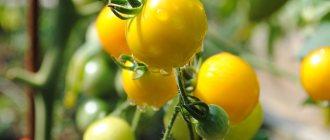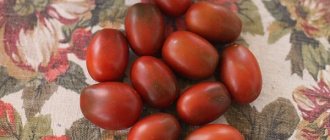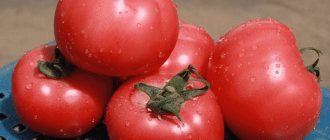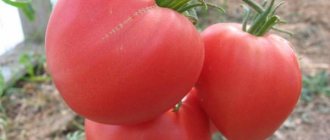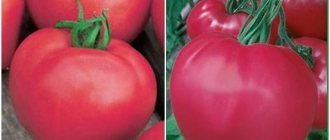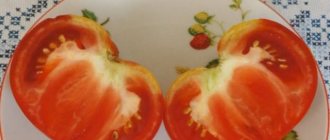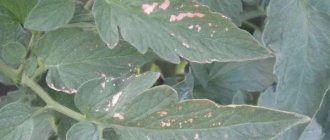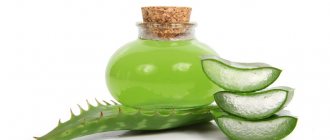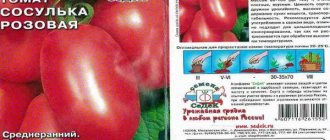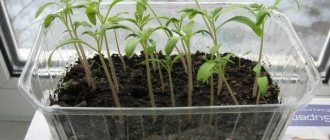Home / Vegetable garden / Tomatoes
Back
Published: 06/03/2018
Reading time: 3 min
0
The Roma tomato is suitable for those who like to prepare thick tomato sauces and juices. Due to its firm texture and rich flavor, this variety is often used in cooking and is especially suitable for drying. This tomato is self-pollinating and compact in size, so it is often chosen for growing on a windowsill.
Despite the fact that the birthplace of this tomato is the United States of America, more and more domestic vegetable growers are planting it in their beds. The seed supplier is Holland.
- 1 Characteristics and description of the variety
- 2 After what and how to plant
- 3 Reviews
Features of cultivation and care
One of the advantages of tomatoes from the Roma variety group is easy care. Seeds are sown to a depth of 1-1.5 cm, planted in the phase of 1-2 true leaves. At the age of 60-65 days, they are planted in open ground or a film greenhouse.
Watering is done moderately and regularly. In the first half of the growing season, they are fed with a mineral complex with a high nitrogen content; after extending the second brush, the emphasis is on calcium and potassium. It is recommended to apply phosphorus in the previous season or give it in an easily digestible form.
Planting density – 4-5 bushes per 1 sq. m. The plants are spreading, with long side shoots, require ventilation and good lighting. When placing 7 tomatoes per meter, gardeners will have to plant them in 1 trunk. This will enlarge the fruits, but complicate care.
Formation consists of removing stepsons up to the first brush. When it starts to fill, remove the lower leaves.
It is recommended to tie Roma to a support. Otherwise, under the weight of the fruit, the bush will fall apart and fall to the ground.
Description of the Roma variety, its characteristics
The Roma tomato variety was created in Beltsville, Maryland, USA in the 50s of the last century. It became the ancestor of the vast majority of commercial cream varieties throughout the Western Hemisphere. Roma is a cross-pollinating variety, not a hybrid, and has been constantly improved since its creation. Basically, breeders try to instill immunity to various diseases in it, and they succeeded - Roma perfectly resists Fusarium and Verticillium wilt, as well as other diseases.
Infographics: a brief description of the Roma tomato variety
Brief description of the Roma tomato variety
By now, Roma is no longer just a variety, but a group of varieties (according to some sources, there are 8 varieties). According to information from English Wikipedia, this tomato ripens in less than three months from the moment of sprouting, and Russian-language sources claim that the ripening period for Roma is 110-120 days. This may be due to differences in climatic cultivation conditions.
The period of fruiting and ripening is extended and can last until autumn. These tomatoes are commercially grown in the USA, Mexico, Australia and the UK. In Russia, they are popular among amateur gardeners in the south of the country, and some grow them in greenhouses in more northern regions. It is possible to grow Roma tomatoes at home on a windowsill or balcony.
Appearance and characteristics of the variety
Roma tomatoes have a determinate growth type with a bush height, according to Wikipedia, of about one meter (the seed package from Agro indicates a height of 35-60 cm). The plant is branched, rather dense, and needs staking. Flower clusters are formed starting from the fifth or sixth leaf, each of them contains ten to twenty tomatoes. Productivity, according to various reviews, ranges from 5 to 15 kg/m2 - probably this variation is associated with growing conditions and care.
The Roma tomato has 10 to 20 tomatoes on each bunch
Determinate varieties of tomatoes include those whose growth is limited and stops after the formation of a flower cluster at the top of the bush.
Description of fruits
The fruits, as already noted, have the shape of a “cream” (sometimes with a “waist”, pear-shaped) and are small in size - their average weight is 60-90 g. The color of the skin and pulp is red (Wikipedia notes that it can be pink). The tomato pulp is dense, fleshy, medium-juicy, and tasty. Like many “cream”, Roma fruits have excellent keeping quality and transportability.
The pulp of Roma tomatoes is dense, fleshy, medium-juicy, tasty
Area of application of fruits
Roma tomatoes are used for whole-fruit canning, even without skin. Excellent for drying, and also good for fresh consumption and vegetable salads. Also used for making tomato paste.
Two or three years ago, on one of the American sites, I accidentally found a recipe for fried Roma tomatoes by the chef of one of the Long Island restaurants. I decided to repeat it, however, I had to replace the Roma tomatoes with local “cream”. The secret of preparation is simple - you need to cut the tomatoes lengthwise into 2 or 4 parts, depending on their size, and place them on a baking sheet covered with parchment paper. Then you need to moisten each slice with olive oil, salt and pepper to taste, then place in the oven and fry them there for 2-3 hours at a temperature of 160 ° C (after the second hour you need to control the process every 30 minutes). When the tomatoes are ready, they are cooled and used to prepare salads, omelets, pasta and other culinary dishes. Tomatoes fried in this way can be frozen and used at a convenient time. In my opinion (and the opinion of my family members), this method of preparing and storing sweet small tomatoes is ideal.
Roma tomatoes are good fried
Slideshow: review of Roma tomato fruits
Table: advantages and disadvantages of Roma tomato
| Advantages | Flaws |
| Early ripeness | It is problematic to buy original seeds |
| Immunity to disease | Does not tolerate extreme conditions well |
| Productivity | |
| Possibility of propagation by own seeds | |
| Good fruit taste | |
| Suitability for whole fruit canning | |
| Keeping quality | |
| Transportability | |
| Excellent product quality |
Table: differences between the Roma tomato and other determinate varieties with a “cream” fruit shape
| Variety | Growing conditions | Height, cm | Ripening time, days | Productivity, kg/m2 | Average fruit weight, g | Taste | Purpose |
| Roma | Under film covers | Up to 100 | In warm climates - 90, in cool climates - 110-120 | 5—15 | 60—90 | Great | Universal, suitable for drying |
| Marusya | Open ground and film greenhouses | 50—80 | 105—110 | 6,9 | 80—95 | ||
| Lady fingers | Up to 100 | 110 | In open ground - 2.7, in greenhouses - up to 15 | 52—70 | |||
| Rocket | Open ground | 15—28 | 122—129 | 488–654 c/ha | 34—58 | Good | Universal |
| Moscow cream | Open ground and film greenhouses | Determinant | Early ripening | 6,8—7,5 | 70—90 |
Advantages and disadvantages
Benefits of Roma tomatoes:
- productivity;
- easy care;
- you don’t have to stepchild;
- beautiful one-dimensional tomatoes;
- extended fruiting;
- high resistance to diseases;
- even tomatoes that are overripe on the bush are not prone to cracking;
- tolerates heat and drought well;
- keeping quality;
- transportability;
- you can collect seeds;
- suitable for all types of processing, including freezing, drying, drying;
- grows in open and protected ground.
Flaws:
- the original variety has an ordinary taste;
- does not tolerate soil soaking;
- It is better to tie up the bush.
Roma is a productive tomato for vegetable gardens and film greenhouses that does not require special care. It is intended primarily for recycling. Other varieties will produce juicy pulp and large fruits with an exquisite taste.
Pests and diseases
The cultivation of determinants is marred by diseases when conditions that are “favorable” for infection agents are created: high humidity with changes in air temperature. It is noted that at this time symptoms may appear on the leaves and stems of the Roma tomato:
- late blight;
- streaky tomato;
- curling leaves.
Late blight is contracted at the end of the growing season. This is why the disease is dangerous, since you can lose the entire harvest. To avoid misfortune, you need to spray the tomato plantings with a solution of Bordeaux mixture three times during the summer.
Symptoms of streaking include curling of the leaves, dark spots, fragility and brittleness of the stem. Infection occurs either from seeds or from diseased plants during pinching.
When a tomato leaf takes the shape of a tube, this indicates a lack of phosphorus in the plants. The fungus is activated by low air humidity and untimely removal of stepsons.
Among the pests that damage the leaves of tomatoes are the beetle and its larvae. Plants can be freed from the parasite by collecting beetles manually or by treating them with insecticidal preparations. In greenhouses, vegetable leaves are eaten by earwigs and woodlice. To prevent pests from causing damage, it is necessary to remove excess shoots in a timely manner.
Roma tomatoes on video
If you have grown Roma tomatoes, please write whether you liked them or not. What was the yield and taste of the fruits in your climatic conditions? How do you rate the disease resistance of this variety? Briefly describe the advantages and disadvantages of this tomato in your opinion. If possible, attach a photo of the entire bush or individual fruits you grew to your comment. Thank you!
Your reviews of the Roma tomato and additions to the description will help many gardeners evaluate this variety objectively and decide whether it is worth planting or not.
Popular tomatoes this year
Mid-season tomato varieties are very popular on the market. The Roma tomato is a vegetable crop, the ripening period of which lasts only 110-120 days, is quite unpretentious in care, and has a number of differences and advantages.
The Roma tomato variety is especially popular in Italy and is often in demand among Australians. Also, Roma tomatoes are very popular in Russia. The versatility in use and ease of growing have not left any summer resident indifferent.
Roma tomatoes are the painstaking work of breeders from Holland. The variety is new. Sweet mid-season tomatoes can provide a bountiful harvest with minimal care.
Aftercare of bushes
Watering and fertilizing should be regular - at least once every week and a half. In case of drought, water the plant with three liters of water twice a week. Step-sonning is also required. The best fruiting is observed when the bush is formed into one stem with a garter to a vertical support. What else is important to consider regarding agricultural cultivation technology:
- For irrigation, only warm, settled water is used. Watering is carried out only at the root.
- When watering, you need to ensure that water does not get on the stem and leaves.
- For the first feeding, mullein and nitrophoska are used, which must be diluted in a bucket of water. The second time they are treated with chicken manure, potassium sulfate and superphosphate. And the last feeding consists of potassium humate and nitrophoska. Fertilizing is alternated at intervals of three weeks.
- Periodic removal of weeds, loosening of the soil and preventive measures against pests and diseases will be required.
See also: The best varieties of tomatoes for open ground and greenhouses in Central Russia
It was previously indicated that the Roma tomato variety reacts negatively to high humidity. For this reason, in greenhouse conditions the room should be constantly ventilated.
Black Roma
Seeds of R. nigra are available for sale. This species has nothing to do with our hero. It is not listed in the State Register. Distributed by little known people. The fruits are plum-shaped, weighing 50 grams, dark red in color with a very dark, almost black tint. This tomato is claimed to be a very productive species (up to 7 kg per 1 square meter), resistant to fungal and viral diseases. There is very little information about him in various sources.
In addition, seed material of the yellow-fruited species Gold Roma is found. But even less is known about this variety than about chokeberry.
Reviews from gardeners
Alexander, Tula: “Our family has long preferred tomato hybrids. Yes, you can’t take seeds from them for planting, but the characteristics of the plants are positive. The Roma tomato variety recently came to my attention. I bought the seeds, planted them - the result was excellent. The bushes don’t take up much space (we have a small plot), and I collect a lot of tomatoes. We eat a little cream with pleasure, and it’s ideal for pickling.”
Daria, Novosibirsk region: “I like to try to grow new varieties and hybrids. The Roma tomato variety made a great impression on me. Low-growing bushes with bright red fruits, similar to plums, have become a decoration of the garden. And there are few worries with them. They don't require a garter. But I removed the extra shoots, so the tomatoes ripened faster. They have a regular tomato taste, but they last a long time. We used them in salads for the New Year. I advise everyone to grow this wonderful tomato.”
Collection and storage
The fruits of the Roma variety are harvested in August. Brown and slightly red tomatoes are recommended to be collected for long-term storage. Once harvested, they can be placed in the sun to ripen. Green tomatoes can be stored for up to three months at normal humidity levels. Tomatoes can be used for canning, freezing, grinding or eating fresh. It is recommended to store the harvested crop in wooden boxes or cardboard boxes. Only whole and healthy tomatoes should be selected for storage.
Positive and negative aspects of the variety
The Roma tomato variety is widespread in America, England, Italy and Australia. The prevalence and popularity of these tomatoes is due to the following positive characteristics:
- During long-term storage, they do not lose their taste, do not deteriorate and retain their presentation for a long time.
- Long-term fruiting (right up to frost).
- Stable immunity to fungal diseases.
- Good yield.
- Low maintenance requirements.
- Due to the small size of the fruits, compactness is achieved when placed in the garden.
- High sugar content.
- Mid-ripening.
- Possibility of propagation by collected seeds.
- Suitable for canning.
However, despite the impressive list of positive aspects, the Roma tomato variety also has negative qualities. Firstly, a problem may arise with the purchase of original seed. Secondly, the plant does not tolerate high humidity very well (it may immediately stop blooming, and this also increases the risk of a fungal infection).
Description
The plant is of a determinate type, medium-sized, 60-80 cm high. The shoot-forming ability and foliage of the tomato are moderate. The internodes are short, which allows the plant to release nutrients directly to the emerging crop. Leaves are tomato-type, long-petiolate, moderately corrugated, dark green. Externally, the plant looks powerful, but compact. On average, about 10 ovaries are formed in the fruit cluster of Roma, but sometimes more prolific clusters grow. The peduncle of the variety has an articulation.
The fruits, beloved by many housewives, are cylindrical and plum-shaped, somewhat widening towards the stalk, with a neat, drawn-out nose, and smooth. An unripe tomato is light green; a ripened one evenly turns a rich red color. The skin is not thick, but very durable. The tomato pulp is fleshy, of good density, moderately juicy, aromatic. As a rule, plum tomatoes have no more than 3 chambers with a small seed content. The taste is real tomato, harmoniously combining sourness and sweetness, the sugar content is increased. But reviews of the taste vary somewhat - from very good to almost grassy. This is understandable, because our hero is not a real salad variety; this variety is excellent for canning. The weight of tomatoes is from 60 to 80 grams, but not more than 100 - 110 grams in closed ground.
